Nata Preparation
[15 Valuable Tips to Crack this B.Arch Exam]
As you have landed on this page, which is titled: Nata Preparation Tips, I assume you are already aware of What is Nata Exam, but still lets do a quick re-cap. Nata is conducted every year by COA ie Council of Architecture for admissions of candidates to first year of 5 year B.Arch Course. Part A of Nata Exam consists of 3 Drawing Questions, & Part B consists of 45 MCQ questions.
Due to the situations arising as a consequence of the pandemic, Nata Exam for the year 2020, 2021, 2022 & 2023 were conducted in online mode only. But for the year 2024, the old standard pattern ie. "Online + Offline"has been resumed. The offline part contains 3 drawing questions carrying 80 marks. And this article, will be a major help as it contains all the do's & don'ts related to Nata Drawing Test.
Table of Content
1. How to Prepare for Nata: Drawing Skills
2. Preparation for Nata Exam: The Crucial 5 Min
3. Nata Exam Preparation: Creativity
4. How to Prepare for Nata 2024: Memory Drawing
5. Nata Entrance Preparation: Examiner's Perspective
6. How to Crack Nata Exam: Speed
7. Nata Exam Preparation Tips: Human Figures
8. Nata Preparation 2024: Doing Practicals
9. Nata Aptitude Preparation: Architectural Awareness
10. How to Crack Nata: Logical Reasoning
11. Nata Preparation Tips: Straight Lines
12. How to score good marks in Nata: Erasing
13. How to Prepare for Nata Exam: Rendering
So, Now lets discuss how we can crack Nata with good marks. Since, there is no shortcut to success, the ideal answer would be through committed hard work over a period of time. But with such little time left for Nata what Smart work we can do so that our results in the exam increase exponentially. Today I will discuss some tips with you, or lets say we’ll discuss some common mistakes which you should not commit in the exam in order to achieve good results. Whatever we’ll discuss here is purely my experience and observation in 15 plus years of my teaching career, not to say that you’ll not find this matter in any guide or tutorials for Nata Preparation.
I assume that you have gone through previous year papers of Nata and have some practice with the basic drawings & syllabus of Nata. We’ll discuss some Macro Tips & Some Micro Tips for Nata Preparation today. These Macro Tips, if followed, are the ones that can increase your performance drastically in the exam & the micro ones are finer details that will give you the winning edge over your competitors.
But before moving further, candidates are advised to check Nata New Syllabus 2024 and Nata Architecture Exam Eligibility. Also, going through Nata 2024 Entrance Details, helps the candidates to understand the scheme of exam
MACRO TIPS FOR NATA EXAM
Since the drawing exam is where you can score the most, my macro tips consist mainly of them.
How to Prepare for NATA?
Tip No 1. DRAWING SKILLS
The most common misconception among NATA aspirants is that if you draw well, then its half the battle won, which is totally false. Though good sketching is essential, the questions are part of technical or engineering drawings and not conventional drawings that students learn in school drawing class. So, developing these skills are equally important. The questions are framed on topics like:
- Effects of light & shadow
- Sense of perspective drawing
- Understanding of scale & proportions
- Memory drawing
- Composing 3 - Dimensional elements
More to Explore...

NATA Study Material
NATA Books: Available in Full, Mini, Combo & Test Series Pack. Doorstep delivery across India.
Details
NATA eBooks
Study at Home with Nata eBooks! Instant Download. Saves Time. Learn at your own pace!
Details

NATA Free Online Test
Free NATA Online Test based on Nata Exam Pattern - Includes Timer, Detailed Results & Answer Key.
DetailsPreparation for Nata Exam
Tip No 2. THE CRUCIAL 5 MINUTES
Tip number 2 is about the crucial 5 minutes before answering the perspective based question. The most scoring question in the drawing test is normally a perspective. After you read the question, give yourself 5 minutes to do the below given exercise, rather than jumping straight to the answer. Believe me, it is half the battle won. You will thank me later for this.
- Get your views correct. Decide which perspective will do best judgement to your question.Lets understand this point with the help of one example: Below given are two perspectives on the topic of crossroads. The first one is a good enough perspective showing all elements of a crossroad like a footpath, road divider, vendors, bus stand and a traffic policeman. But the second perspective looks more interesting and will fetch more marks simply because the view is better than the first one and showing more details. This means your choice of perspective can also land you with more marks. So, choose wisely!
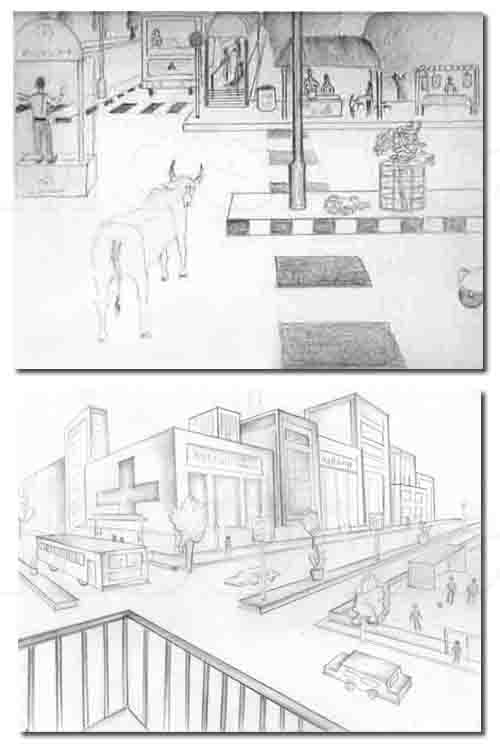
- Note down whether the question is to be coloured or pencil rendered: Many students in a hurry to answer, don't read the question properly and often fill colours when asked to render with pencils. This is a very silly mistake and students often loose marks because of it.
- Quickly note down what elements are required in the question.
- Make a rough top view.
- Draw a rough sketch.
Also Read:
Lets undrstand the last three points with the help of an example:
The question given below is from Nata 2017 Question Paper and is one of the toughest questions asked in Nata Exam till now:
Q1. One late afternoon, you along with your family members were enjoying a boat ride along a river and viewed a spectacular sunset. You noticed that the boat was moving from south to north and all of you were facing north. Suddenly your youngest brother shouted and told everybody to see the river bank on your right side. You saw a series of high-rise apartment buildings interspersed with trees. But, in the middle, there was a beautiful river ghat, a garden and a small white mosque adjacent to it. Lots of birds were flying around and sitting on its golden dome. In the concrete jungle, the small structure seemed to be a nice relief. Develop a coloured sketch (use dry colour) of what you experienced.
Please note that the above question has a lot of infomation and its advisable to draw a top view and note down the main elements so that we don't miss out on anything.
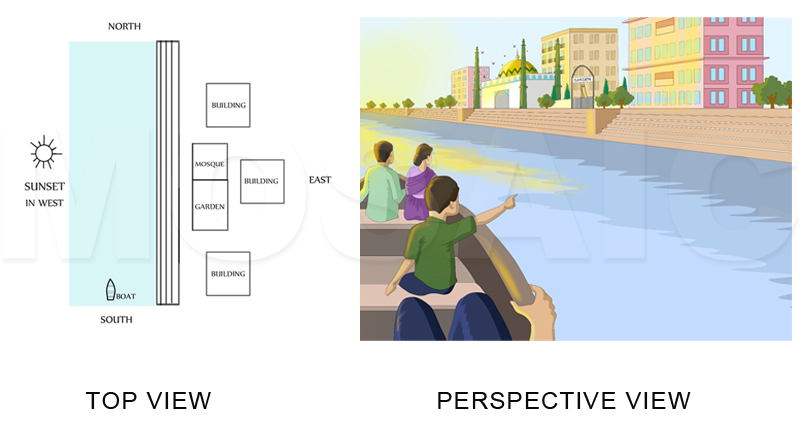
Get here "Nata Previous Year Question Paper & Nata Answer Key"
Are you preparing for NATA? |
| Prepare with Mosaic's NATA Entrance Material |
NATA Exam Preparation
Tip No 3. CREATIVITY
Add something to your answer that is above average. Add a dash of creativity: that is where the toppers score more marks. Merely drawing the correct answer is not enough. In order to score those 10-15 marks that toppers score, you need to add something that is interesting and which sets you apart from the rest. Lets understand with the help of one example:

You can view two answers to the question "Imagine you are an ant inside a ladies purse and you can see a mobile phone, telephone diary, comb, cosmetics, etc. Draw the view and render in pencil only." The first example is a standard answer...It is correct but out of 100 around 95 students will make something like this ie. a cuboid shaped purse. Now look at the second example....some students think beyond average and score more marks......such is this example.....of drawing a fan shaped purse instead of a cuboid one.....this one will eventually get more marks as it stands out from the rest and adds interest.
Creativity is a mysterious trait. Many people have tried to define creativitiy in their own ways but there is no single universally accepted definition. It is difficult to summarise in a few lines but we can say that creativity is the ability to come up with new, original ideas which are not conventional. It is the breaking away from the stereotype, routine, accepted set of thoughts and possessing a deeper insight to problem solving. In short, a creative person experiences rebirth everyday with his or her ideas.
Now the question is “Can I be more creative than I am right now? Though there are exercises that improve your creative skills, this is not an overnight solution. It takes place over a period of time.
Now that not enough time is left for Nata, working on this skill won’t give much results.
What I recommend is that you have a good nights sleep before the exam and attempt the exam in a relaxed state of mind.
How to Prepare for NATA 2024
Tip No 4. MEMORY DRAWING
A lot of students do excellent copy drawing but have major problems while drawing from memory. The only solution to this problem is good observation and lots of practice. Live Sketching will also help. So, use your discretion while devoting time to this topic as good drawing skills don’t develop overnight. There is no shortcut to developing skill in this topic. Only time, patience and dedication is the key.
NATA Entrance Preparation
Tip No 5. What are the Examiners looking for?
The aim is to make you aware of the most common mistakes made in the Nata Drawing Questions by the students. Here, I provide critical analysis and feedback on the drawings attempted by students.
Q1. Imagine that your size is 6 cm & you are standing on kitchen platform. You can see your mother making chapattis, the sabzi cooking on the gas stove & other utensils & pots. Draw the view. Render in pencil only.

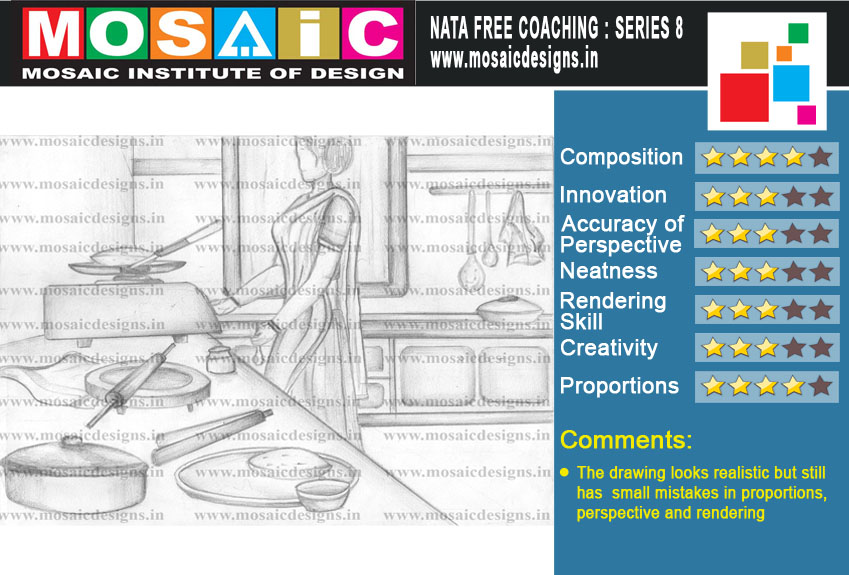
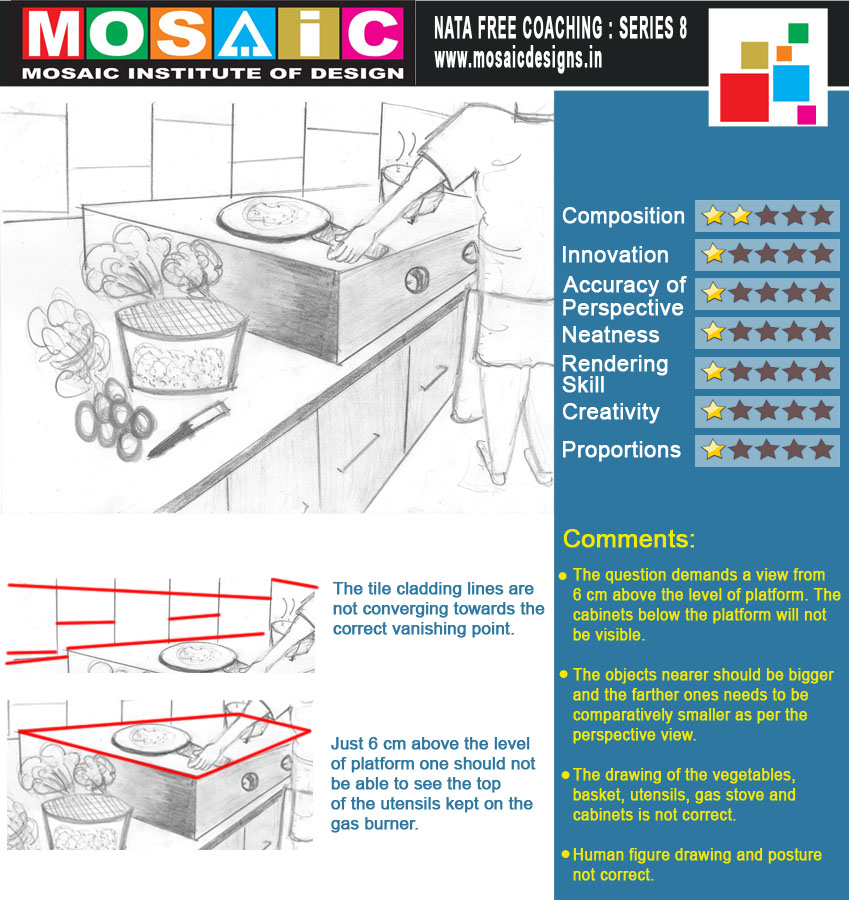
Comments: The drawing has a lot of flaws. The student needs to work on basics of drawing and perspective making.
Q2. A caterpillar is sitting in the basket of a vegetable vendor. The vendor is sitting on a pavement waiting for daily buyers with the basket placed on the floor. Draw the view of the caterpillar in the space provided and render in pencil.
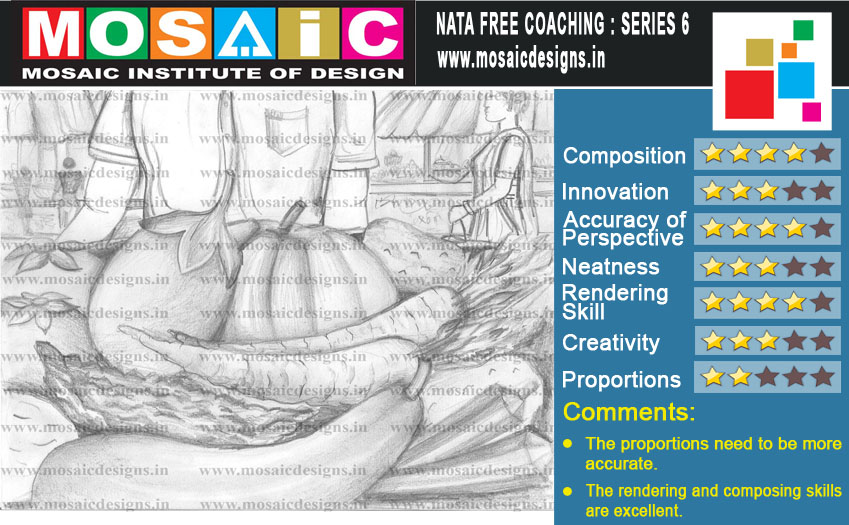
Q3. Imagine that you are standing on top of a train coach which is stationary at a railway station. Standing at such a height, draw the view of the station around you and render in pencil.
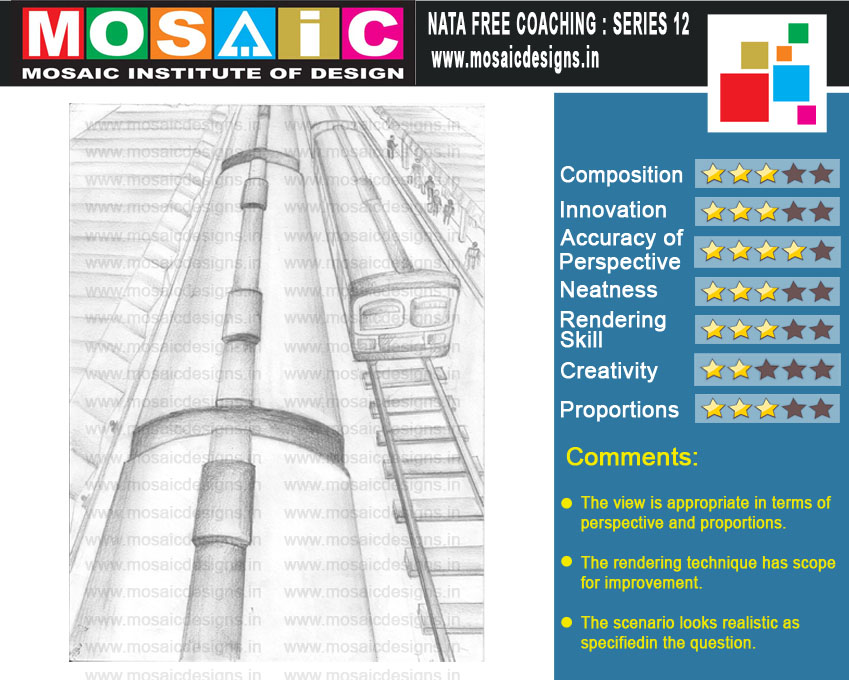

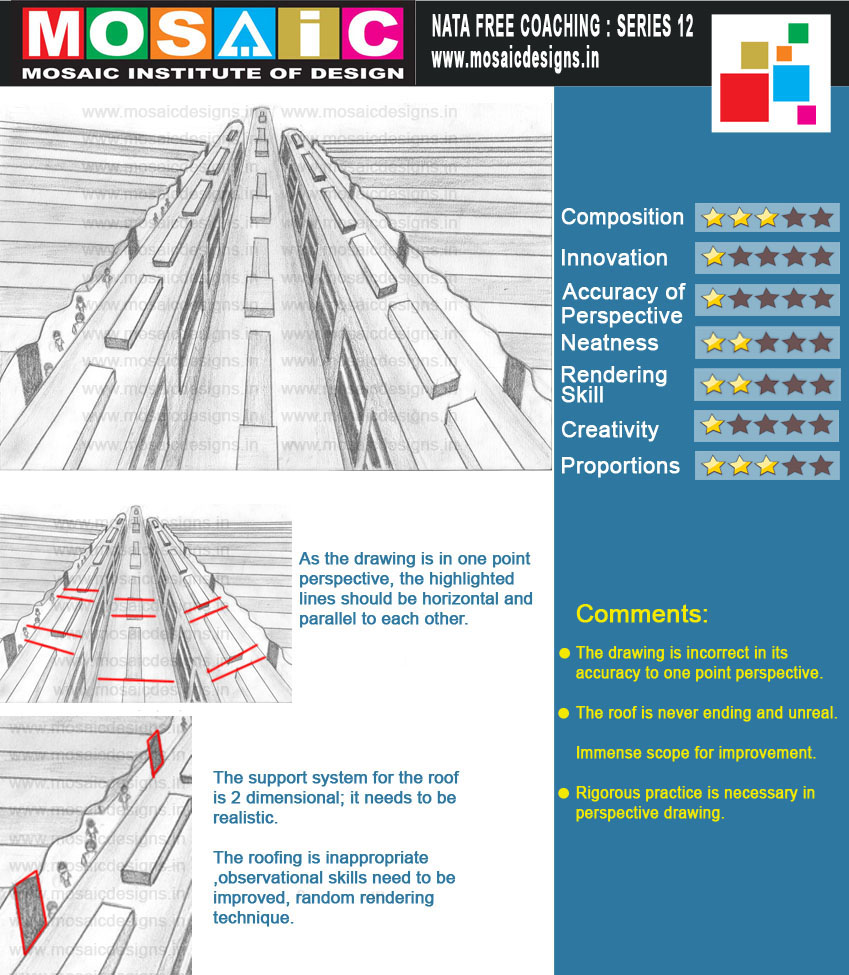
Q4. Make an interesting 2-D fruit basket and fill in with an interesting colour scheme.
We’ll quickly note what all is asked in the question
- A Basket with Fruits
- Everything in 2D……That means no 3D
- The composition needs to be coloured
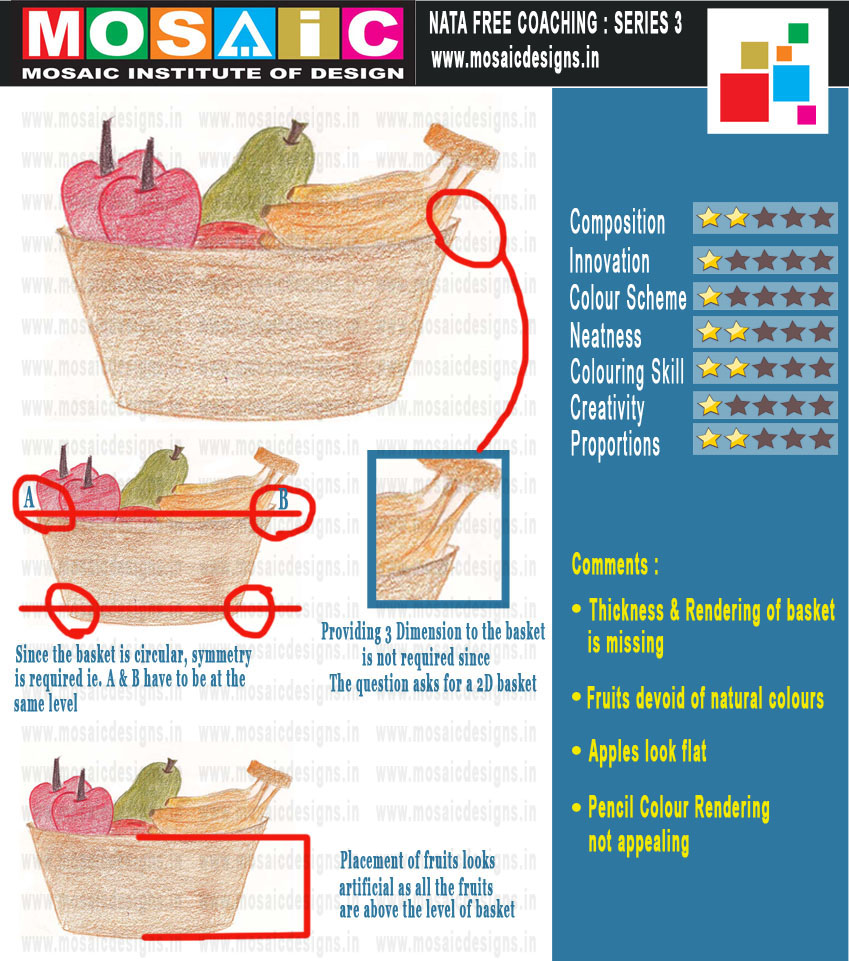
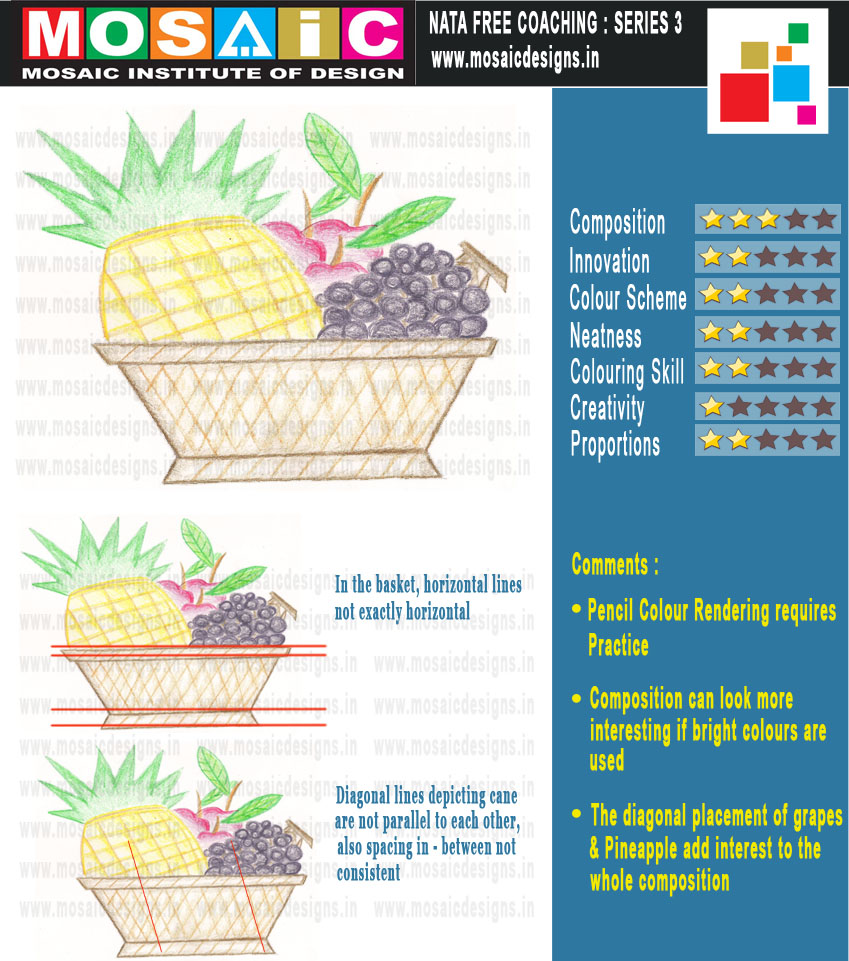
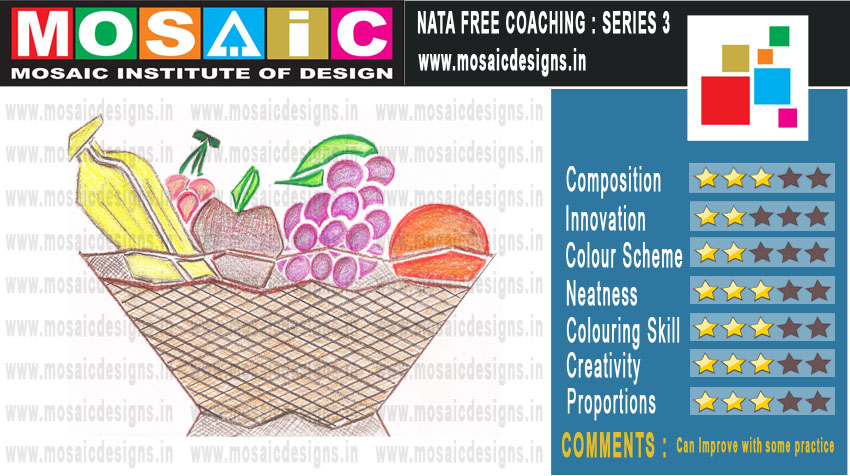
How to Crack NATA Exam?
Tip No 6. SPEED
Understand that your drawing & creative skills are useless if you are not able to present your thoughts in the exam in the limited amount of time. You stand to lose marks for the questions you fail to answer or which are left incomplete, it doesn't matter how good you are at your work. So speed is equally important.
How to increase your Speed?
Learn to work in layers. It has direct co-relation to your speed.
By layers I mean, don't create and focus on one portion of the drawing, instead work on the full composition: from rough to fair, in layers. There is a specific benefit if you work this way: Even if you are not able to complete your answer ie. maybe the rendering portion is left out, still the examiner will be able to make sense out of your drawing, and you will get marks that you deserve.
Also Read:
NATA Exam PreparationTips
Tip No 7. HANDLING HUMAN FIGURES
Understand Human Figures: If you can draw good human figures, good for you. But if you can’t, then what to do? With little time left for the exam, there is no point wasting your time practicing human figures. But I strongly advice that you get your stick figures or block figures correct, if not the finished ones. You will loose some marks for unfinished figures, but those marks will be miniscule. If the perspective view is correct & the posture & proportion of the figure is correct, most examiners will give you marks. Also note that the examiners are looking for future Architects & not Fine Artists. Their main aim is to establish that the candidate can imagine the correct view in his or her mind.

Please let me clarify that this is not a solution to avoid human figure drawing. This is only a shortcut for those who after repeated practice, fail to draw correct human figures ….so that they don’t loose too many marks
NATA Preparation 2024
Tip No 8. DOING PRACTICALS
Students created 2D Composition with the help of basic geometrical shapes like squares, circles, rectangles and triangles. We noticed that attempting the exercise directly without complete understanding resulted in below average compositions. So we decided to add a bit of fun. After a basic theory session on elements and principles of design and colour schemes, we started with the practical exercise. Students used coloured paper cut – outs of basic geometrical shapes and thread to represent the following.
What were the benefits of the exercise
- Playing with shapes was a fun exercise.
- Students enjoyed their work.
- Helps in better understanding of exercise.
……..And this is what they attempted
NATA Aptitude Preparation
Tip No 9. ARCHITECTURAL AWARENESS
As a Nata Aspirant, students should brush up their knowledge about important Architects & their works. These questions can constitute a large portion of the Multiple Choice Questions. Lets go through some famous buildings and interesting facts related to them.

Hawa Mahal was built by Maharaja Sawai Pratap Singh and designed by Lal Chand Ustad in the year 1799. Hawa Mahal is a very famous structure built in red and pink sandstone in Jaipur city. The high screen of the Mahal faces the street. In olden times, women of the royal household used to enjoy street festivals from behind the screen, at the same time no outsiders were able to see them. Hawa Mahal is also called “ Palace of Winds” because it uses the Venturi Effect, allowing cool air from the numerous Jharokhas decorated with Latticework, cooling the interiors in hot weather.
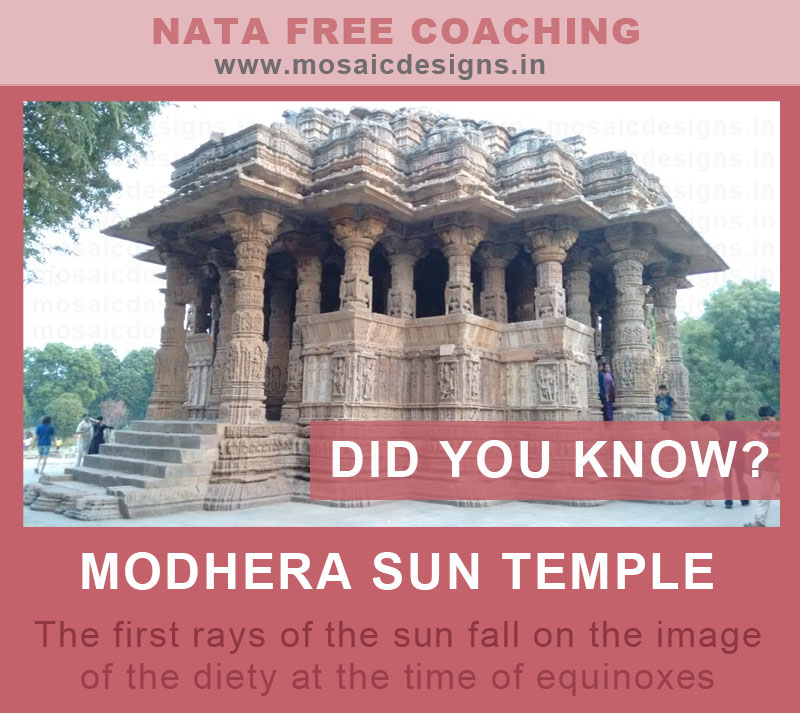
Modhera Sun Temple was built by King Bhimdev of the Solanki Dynasty in 1026 AD. The temple, 102 km from Ahmedabad, situated on the banks of river Pushpavati, is dedicated to the Hindu Sun – God. A very interesting feature of the temple is that the first rays of the sun fall on the image of the diety Surya, or the Sun God at the time equinoxes. Currently the temple is under the supervision of Archaeological Survey of India (ASI). Prayers are not offered in the Temple now.

Gol Gumbaz is the mausoleum of Mohammed Adil Shah, who was the Sultan of Bijapur in Karnataka. The structure in dark grey basalt, was completed in 1656. It was built in Deccan style by architect Yaqut of Dabul. It has the largest dome in India and second largest in the world, with a diameter of 124 feet. Gol Gumbaz is famous for its marvelous acoustic properties. Worth mentioning is the “Whispering gallery,” where even the softest sound can be heard on the other side of the mausoleum.

Situated on the Chittar Hill in Jodhpur Rajasthan, Umaid Bhawan Palace is one of the largest royal residences in the world. It was built by Maharaja Sawai Jai Singh II, for the sole purpose of providing employment to the famine – stricken people of Jodhpur. Building work for the palace started in the year 1929 and completed in 1943. The Maharaja commissioned Henry Vaughan Lanchester as the architect of the royal residence. Built in golden – yellow sandstone and made in an area of 26 acres, the palace employed around 2000 to 3000 people for its construction. In 1971, the palace was divided into three parts: as the residence of the royal family, a museum showcasing the history of the royal Jodhpur family and a luxury hotel
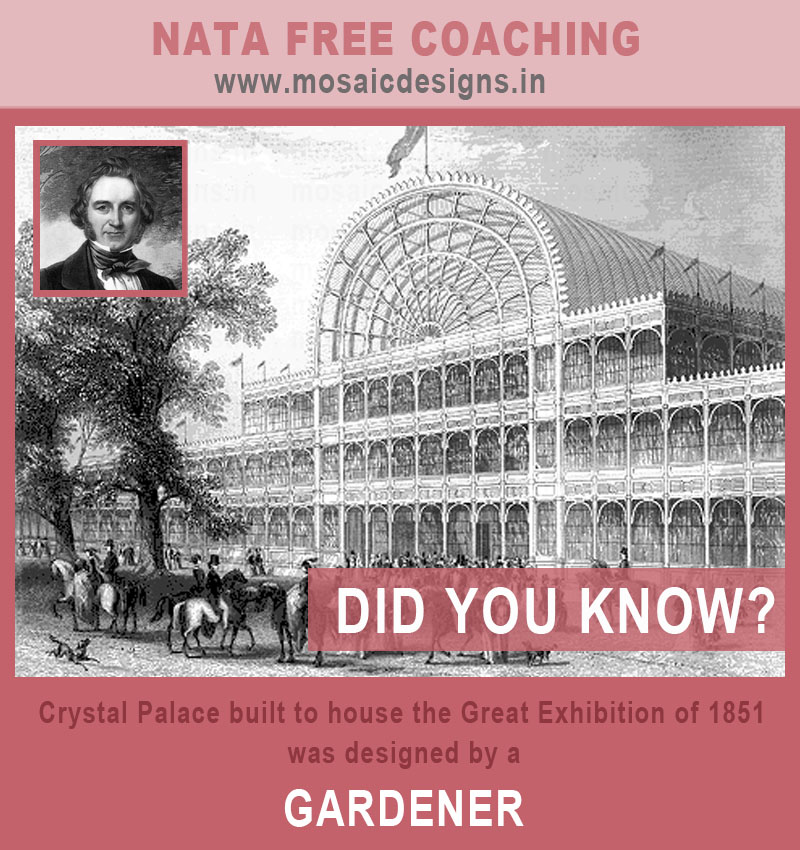
How to Crack NATA?
Tip No 10. LOGICAL REASONING
Logical Reasoning is part of almost all competitive exams in India and a lot of material is available in the market for the same. The key to successfully crack this topic is thorough understanding of the topic and lots of practice. Lets watch this video on Direction Test.
MICRO TIPS
NATA Preparation Tips
Tip No 1. DRAWING STRAIGHT LINES
Scale is not allowed in the exam. So practice freehand lines. Lots of them: verticals, horizontals and Diagonals.
Students assume that using a scale will not be much of an issue & a bit of use is OK. But believe me, the examiners are experienced and they can make out the difference between a hand drawn line and the one drawn with a scale.
You’ll loose marks if you use scale….thats for sure.
How to Score Good marks in NATA?
Tip No 2. ERASING
In questions requiring drawing, always draw with a light hand first, doing mainly the outlining without the details. When you are satisfied with the proportions & the rough outline, you may finalize. You will save a lot of time that students normally waste in erasing & re-drawing. Also, it is always easy to rub a light pencil work, darker ones always leave a mark.
Also unnecessary erasing eats into the surface of the catridge sheet making it unfit to render later on. Believe me, I’ve also seen holes in sheets as a result of erasing.
So, strictly speaking, keep the use of eraser to the minimum, only if it is very necessary.
How to Prepare for NATA Exam?
Tip No 3. RENDERING
Rendering in the exams is allowed in only two mediums: pencils and colour pencils. So, practice and master the above mediums.
NATA Preparations
Tip No 4. SHEET SIZE
Don't practice in A3 size sketch books. Work in A4 size as that is normally the standard size of answer sheets in the examinations.
This is necessary, because if you practice in A3, you tend to develop a habit of drawing big. Then in the exam, you’ll find it difficult to contain your drawing in a small size.
How to Prepare for NATA at Home?
Tip No 5. SOLVING PAPERS
Solve at least 10-20 previous papers of NATA within the time limit. Find out a comfortable sequence of answering the paper. This will acquaint you with the paper pattern and expose you to a variety of questions, giving you a good practice.
LAST BUT NOT THE LEAST
What Stationary to use?
Time and again students have asked me about the best stationaries available in the market to use for Nata Exams. Though stationary can be a personal choice, but there are some prominent and reliable brands available in the market which can be relied on. I'll list them as under:
Note: Please note that the names of brands mentioned below are not sponsored, but listed based on years of experience using them.
Colour Pencils - Without doubt, you can try Staedtler to practice colour rendering. The leads of colour pencil are soft and smooth, providing a fade resistant and excellent coverage on catridge or ivory sheet. The leads don't break easily, extra bonded and easy to sharpen. Dependeble for Nata Exams. Other options can be Faber Castell, Camlin
Rendering Pencils - The most widely used & recommended are Faber Castell Pencil Set. They provide excellent results on catridge & ivory sheets. The leads are tough,smooth to work and do not break very easily.
Eraser - Most of us use Apsara Non-Dust Eraser, and I must say it does the work very well. Eats little into the paper surface. And ideal for Nata Drawings.
Drawing Books - Most of the Drawing Books available at standard stationaries work well. The paper quality is not very fine but perfect for daily practice for Nata Drawings. However, it should not be used for fine work....A thick quality paper is recommended. The ideal size is A4 size to practice, as it is the standard for Nata Exams
Don't mug up G.K. books but be more aware of the construction work happening around you. If you cannot find a construction site, look around your home. Observe different Architectural Materials that have been used and try to find the role of Architectural features used, like the Lintel or Sill etc. Talk to people who have studied Architecture...see their works...and try to understand the field, see if you can relate to them. Read the newspapers regularly. Increase your observation power. Try to find out about famous architects & their works & how they have contributed to the field of architecture. Read books / magazines & develop a genuine passion for your field.
Develop your Aptitude for the field of Architecture. Find your own deep and compelling reason to successfully clear Nata. Motivate yourself. Work with enthusiasm & you will be amazed at your ideas & creations.
For XII class students: Plan your time well for Nata preparation if you are also preparing for other entrance exams along with Nata. Use your time effectively with a time table. Don't start your preparations after you finish your XII boards - The earlier you start, better for you.
NATA Preparation 2024 Frequently Asked Questions (FAQS)
Ques 1. How to Prepare Nata Exam?
Ans 1. The first step towards Nata Preparation is acquainting oneself with the Latest Nata Exam Pattern. Go through the previous years papers of Nata, try to solve the questions in the specified time limit. Identify the question types that you find difficult to answer. Try to develop the aptitude required & learn concepts behind the respective questions. You can download Nata Previous Questions
Ques 2. When should I start preparing for Nata?
Ans 2. An early start along with a genuine interest in Architecture can prove to be an unbeatable combination for a good Nata Score. It not only provides you enough time to explore the field & evaluate your decision based on your interest & aptitude, it also creates a strong foundation to excel in the years to come.
Ques 3. Can I crack Nata in 6 months?
Ans 3. The answer is a "yes" & "no" both. As Nata measures a candidate's aptitude in the field of Architecture, the answer to the above question may vary from candidate to candidate. Aspirants with natural aptitude might crack Nata with limited time at hand, whereas others may require more time & external help.
Ques 4. How to prepare for Nata exam at home?
Ans 4. Aspirants can order Nata Study Material by Mosaic & prepare from the comforts of their homes. The full study material includes books, pdfs, video packs along with solved & unsolved Previous years papers and Mock Tests of Nata.
Ques 5. How to Clear Nata exam?
Ans 5. Overall qualifying marks for Nata 2024 shall be 70 marks out of 200 as aggregate of Part A & part B. But, if you wish to get admission in a good B.Arch College, you need to aim much higher than the passing marks. Check Nata Cut Off marks for Top B.Arch Colleges in India
Ques 6. How to prepare for Nata in 1 month?
Ans 6. A strict time table, an excellent Nata Preparation Material & a laser sharp focus can help you prepare for Nata in a limited time period. Pay extra attention to the drawing part, as many students are not able to complete the drawing paper on time & lose the much required marks. It is important to practice drawing questions with a timer along with the rendering mediums to attain good speed. Practice, Practice & Practice Perspectives, 2D Compositions, 3D Compositions & Human Figures to answer the Nata Drawing test confidently in the limited time period.
ALL THE BEST FOR NATA EXAMS
About the Author: Anu Handa is an Interior Designer, DIY Artist, Co-Founder and Educator at Mosaic Institute of Design. She has been the lead blogpost writer at www.mosaicdesigns.in since 2009. Her educational background in Interior Design, Urban Planning and the English Language has given her a broad base to cover a range of topics in her articles. Anu has spent 15+ years training Design & B.Arch Aspirants for entrance exams.
Passionate about Design Education, she’s briefly worked with Annamalai University as a paper setter for Design Exams. Likes to write about Design, Architecture and related fields, on online platforms like Quora. Aims at challenging the conventional & age old teaching methodology.




































